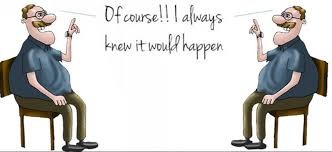The beauty of hindsight is that, once we get through the negativity of what went wrong in the past, it allows us to see what we wouldn’t do again, and to create new patterns for ourselves. What we don’t always acknowledge though, is a concept known as ‘hindsight bias’.
You may have often told yourself ”I knew it, I knew it all along”, in a circumstance such as having aced an exam that you’d only studied for the night before, or when a colleague repeats an act of negligence they had for which they had prior form. However, we were unlikely to have known all along these scenarios would happen again; we only feel we should have known. The thing is, if you feel like you knew it all along, it is likely you won’t stop to examine why something really happened.
This is due to the brain selectively recalling information and then making a narrative of the available evidence. We generate that narrative and it tricks us into seeing the scenario we’re mulling over as totally foreseeable. As the event was previously unexpected, our brain has processed it so as to be orderly and systematic so that we can put some closure on events.
I’ll often meet clients who have given a lot of thought to ‘hindsight’, or 20/20 historical vision. In this mindset, past events seem to be more prominent than they appeared while they were occurring, and often more simplified in cause and effect. Hindsight bias can also give rise to the belief that what happened was inevitable, which can prevent the exploration of possibilities for the future.
An approach which can help us articulate a new narrative to what we feel has gone badly in the past is to stop and think carefully about the causes of the situation. It is also important to consider what factors were influential at the time and to dissect other parts of the situation which may have been omitted whilst creating an “I knew it” narrative
Have you considered the themes you will be concentrating on for the next 5, 10, 20 years? It is critical to map the road forward, remembering that the past does not shape the future. Your hindsight bias can be slowly silenced by recognising the many, many avenues that can be taken to create your future. They are filled with possibility. Identify the best of those possibilities, and pursue them to create your future.

